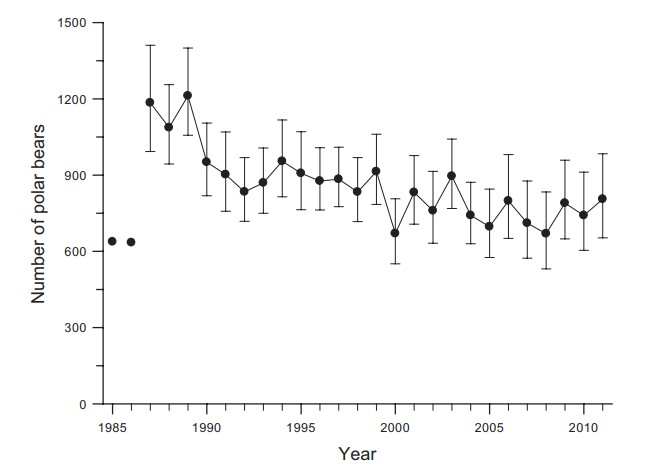
Fails to grasp significance of observation: Polar bears were heavily harvested in the 1950s and 1960s. An increase in polar bear population size since the 1950s does not demonstrate that polar bears are not affected by climate change, but rather that an agreement was signed in 1973 stating that harvesting should be done at sustainable levels.
Inadequate support: There is no scientific evidence provided to support the claims made in the video or the figure showing increases in the global polar bear population size over time.

REVIEW
CLAIM: “In 1950, there were around 10,000 polar bears globally. Today, polar bear populations are near 39,000. That alone pokes a hole in the whole plight of the polar bears story. Polar bear populations are increasing dramatically as the planet has warmed.”
REVIEW
The claims appeared in a Facebook video published in October 2020 by “Climate Realism”, a project run by the Heartland Institute, which has a history of publishing climate information inconsistent with findings from the scientific community. The video suggests that global warming is not a threat to polar bears because the global polar bear population increased in size since 1950. Contrary to this claim, scientific evidence demonstrates that sea ice loss induced by climate change is currently the greatest threat to the long-term survival of polar bears[1-3].
Polar bears rely on sea ice to hunt seals (their primary prey), mate, establish dens, and move to new regions seasonally[2]. Loss of sea ice is occurring in almost all polar bear subpopulations. Scientists can evaluate the effects of climate change on polar bears by correlating local losses in sea ice habitat with polar bear subpopulation size. Several studies using this approach found that loss of sea ice has already negatively affected some subpopulations, including Western Hudson Bay and Southern Beaufort Sea (see figure below)[4,5].
Figure—Estimated size of the Western Hudson Bay polar bear subpopulation using data from capture-recapture models from 1984-2011. From Lunn et al. 2016[5].
In addition to declines in population size, loss of sea ice also affects polar bear body condition and survival rates. “Long-term monitoring studies in Canada suggest that polar bear body condition, survival and population growth rates are all negatively impacted by declines in the availability of sea ice habitat and there are no data to suggest that polar bears are thriving in areas where sea ice has significantly declined,” said Gabrielle Lamontagne, a communication advisor for Environment and Climate Change Canada.
The trend of the global polar bear population is unknown, according to the IUCN Red List[6], however trends can be observed at the subpopulation scale. The current global polar bear population is estimated to be 20,000 to 26,000 bears, which are distributed among 19 subpopulations[6,7]. Of the 19 subpopulations measured by the IUCN Polar Bear Specialist Group, only two increased, four declined, and five were stable in 2019. The other subpopulations did not have enough data to demonstrate short or long-term trends (see figure below).
Figure—Geographic distribution, size, and trends of 19 polar bear subpopulations measured by the IUCN Polar Bear Specialist Group. Colors reflect subpopulation trends in 2019. Shape and size represent subpopulation size, measured in the number of bears. Adapted from the IUCN Polar Bear Specialist Group.
These data directly contradict the video’s estimate that the global polar bear population is 39,000 bears. Although there is no scientific source cited in the video, the inaccurate number was most likely drawn from a blog published by Susan Crockford in March 2019. As stated in Harvey et al. (2018), “as of this writing, Crockford has neither conducted any original research nor published any articles in the peer-reviewed literature on the effects of sea ice on the population dynamics of polar bears.”[8]
While the global polar bear population may have increased from 1950 to today, data on polar bear populations was limited or non-existent prior to the late 1970s, as described by the reviewers below. During this time, hunting, killing, and capturing polar bears were the biggest threats to their survival. In 1973, the Agreement on the Conservation of Polar Bears was signed to address these practices[7]. Specifically, Article II of the agreement states, “Each Contracting Party shall take appropriate action to protect the ecosystems of which polar bears are a part, with special attention to habitat components such as denning and feeding sites and migration patterns, and shall manage polar bear populations in accordance with sound conservation practices based on the best available scientific data.”
This agreement likely led to an increase in the global polar bear population in the 1970s[9]. But as stated in Hunter et al. (2015), “there is no evidence that these increases continued, and such recoveries, where they occurred, are irrelevant to the effects of recent changes in the availability of sea ice”[9].
Overall, the claims made in the video are not consistent with scientific evidence demonstrating that loss of sea ice habitat due to climate change is the biggest threat to the long-term survival of polar bears[10]. Some subpopulations of polar bears have already declined due to losses in sea ice. The claim that the global polar bear population is 39,000 bears is unsupported and inconsistent with current evidence.
SCIENTISTS’ FEEDBACK
Andrew Derocher, Professor, University of Alberta:
[comment from a previous evaluation of a similar claim]
There are 19 subpopulations of polar bears across the Arctic. Four are likely decreasing (according to the IUCN/SSC Polar Bear Specialist Group – of which I am a member). Five are likely stable and two are likely increasing. The remainder are unknown. If one considers the “global” population as if there is 1 population in the Arctic, the claim of “growing” cannot be supported.
While we have zero data on polar bear abundance until the late 1970s, polar bears were commercially harvested until ca. 1973 when the Agreement on the Conservation of Polar Bears was signed that introduced harvest controls. Polar bears, while based on poor or no data, were heavily depleted in the 1950s-1960s. So, from 1970 to 2020, polar bear populations overall increased. This of course ignores areas that have now declined (Western Hudson Bay, Southern Hudson Bay, Southern Beaufort Sea) and M’Clintock Channel that was severely overharvested post-1973. It’s a word game. Past increases were due to harvest controls. Current declines are due to climate change associated loss of sea ice[1,2,3].
Ian Stirling, Adjunct Professor, University of Alberta:
First, and most importantly, there never was a factual basis for the “estimate” in 1950 as no population studies of polar bears had been done anywhere in the Arctic at that time. The number was a genuine “guestimate”, i.e., simply a guess based on what little was known before there had been any population surveys or research on the relationship between the polar bears and seals. Another important additional ecological aspect was that in 1950, no one realized how enormous the populations of ringed and bearded seals were around the circumpolar Arctic or, consequently, what their potential might be for supporting much larger populations of polar bears than were normally seen not too far offshore where some humans traveled regularly. As serious quantitative population-level surveys began in the late 1960s and early 1970s, in response to the heavy overharvesting that had taken place in several populations, mainly through the 1960s and into the early 70s. Much of this new research was facilitated by increased research budgets and the development of more effective and safer immobilization drugs which, together, made the first quantitative studies of a few populations possible. So, although no one has any factual idea about the size of the circumpolar population of polar bears in 1950, it seems pretty clear that the total guestimate of 10,000 was likely low, even in the face of heavy overharvest of some populations. However, given that there were simply no quantitative data with which to estimate population size in 1950, the only accurate statement that can be made is that we simply don’t know.
[the following comment is from a previous evaluation of a similar claim]
As for real numerical information on polar bears, if anyone wants to know how much can be said with as much reliability as is possible, they should go to the web site for the IUCN Polar Bear Specialists Group (which I am also a member of). Note on the left hand side there are headings that give estimates and summaries (with references) of knowledge for all the 19 populations. The estimates for some populations are labelled as current, outdated, and nonexistent for others, particularly in Russia, so it is not technically possible to have a “total estimate”. In reality, it is the status and trends of the 19 individual populations that count. Several populations, such as those in western and southern Hudson Bay, and the southern Beaufort Sea are confirmed unequivocally, from long-term data, to have declined significantly as a direct result of climate warming causing steady loss of sea ice[4,5]. Some other populations are likely also declining, just judging from the extent of the steady loss of ice but we lack long-term data with which to make that assessment, and a couple are doing OK, such as Foxe Basin and Davis Straight, and one seems to be increasing (M’Clintock Channel). However, unless we are able to stop global warming and maybe even start to cool the planet, all populations will decline severely and some will be lost forever[9,10]. The steady loss of sea ice in all subpopulation regions is well summarized by Stern and Laidre[2]. Dr. Derocher and I also published a review a few years ago that gives the state of knowledge about the effects of climate warming on polar bears[1].
REFERENCES:
- 1 – Stirling et al (2012) Effects of climate warming on polar bears: a review of the evidence. Global Change Biology.
- 2 – Stern et al (2016) Sea-ice indicators of polar bear habitat. The Cryosphere.
- 3 – Regehr et al (2016) Conservation status of polar bears (Ursus maritimus) in relation to projected sea-ice declines. Biology Letters.
- 4 – Bromaghin et al (2015) Polar bear population dynamics in the southern Beaufort Sea during a period of sea ice decline. Ecological Applications.
- 5 – Lunn et al (2016) Demography of an apex predator at the edge of its range: impacts of changing sea ice on polar bears in Hudson Bay. Ecological Applications.
- 6 – Wiig et al (2015) Ursus maritimus. The IUCN Red List of Threatened Species.
- 7 – Derocher et al (2013) Rapid ecosystem change and polar bear conservation. Conservation Letters.
- 8- Harvey et al. (2017) Internet blogs, polar bears, and climate-change denial by proxy. BioScience.
- 9 – Hunter et al (2010) Climate change threatens polar bear populations: a stochastic demographic analysis. Ecology.
- 10 – Molnar et al. (2020) Fasting season length sets temporal limits for global polar bear persistence. Nature Climate Change.
UPDATES:
- 30 October 2020: This post was updated to include additional comments from Ian Stirling.




